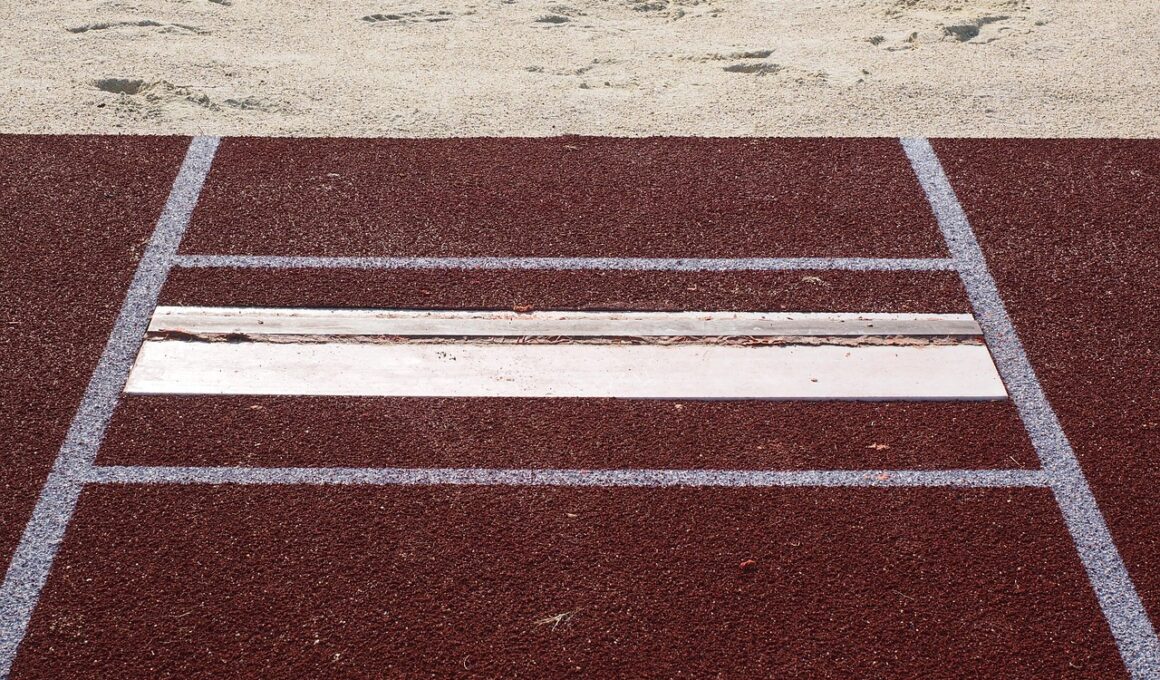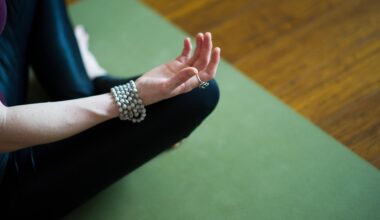The Science Behind Youth Long Jump: Biomechanics Explained
The long jump is a multifaceted athletic event that requires understanding biomechanical principles. Youth athletes, through proper training, can enhance their performance significantly. Key factors to consider include takeoff technique, speed, and body positioning. Proper coordination leads to optimal energy transfer during the jump. For effective performance, athletes should focus on maximizing their horizontal speed towards the takeoff board. This speed directly influences the jump distance. Additionally, the angle at which they take off plays a critical role in their jump’s success. A well-executed jump maximizes height and distance through angles optimized for personal physique. Proper training should include techniques to improve these factors, ensuring that youth athletes are well-prepared. Conditioning programs tailored to these biomechanical aspects can enhance overall performance. Coaches must monitor progress and adjust training regimens accordingly. Engaging in drills that foster muscle memory is essential—athletes should practice consistently to build their jumping skills. The synergy between speed, technique, and body mechanics is crucial for any aspiring long jumper in youth athletics.
To develop proficiency in long jump, athletes should incorporate various training techniques. For starters, understanding the importance of warm-up routines cannot be overstated. Effective warm-ups enhance flexibility and reduce injury risk while preparing muscles for intense activity. Youth athletes should focus on exercises that promote joint mobility and muscle activation. This prepares their bodies for the demands of long jumping, engaging critical muscle groups. Coaches should emphasize plyometrics as a component of training. These explosive movements develop power crucial for effective takeoffs. Exercises like box jumps and depth jumps can be particularly beneficial. Additionally, practicing approach runs helps develop rhythm and speed; coaches can set up drills focusing on this aspect. Strength training cannot be overlooked, as it builds the foundational power necessary for optimal performance. Athletes should focus on both lower and upper body strength to enhance their jumping ability. As they improve, they can progress to more advanced training methodologies. By diversifying their routines, they can make significant strides in their performance, mastering the essence of biomechanics in the long jump.
Biomechanical Principles of Long Jump
Biomechanical principles are essential for youth long jumpers. Understanding the physics underlying the jump influences performance immensely. One of the critical factors is the takeoff phase. Proper technique in this phase dictates the trajectory and distance. Youth must learn to perform an optimal takeoff angle, traditionally around 20-30 degrees. This ensures maximum lift and distance. Analyzing foot placement during takeoff is equally important; it should be precise to allow powerful propulsion from the board. Another biomechanical element is the role of gravitational force that acts on the jumper. Athletes must be aware of how gravitational pull affects their flight. The body’s center of mass plays a crucial role; keeping it stable allows for better control during flight. The landing phase requires attention as well—athletes should focus on maximizing their landing posture to minimize energy loss upon touch down. Drill repetitions help reinforce proper biomechanics in every jump. Coaches should utilize video analysis, allowing athletes to visualize their technique. Incorporating feedback promotes growth, enabling youth jumpers to align with effective biomechanical practices, and enhances their overall performance.
Nutrition plays a vital role in the training and performance of youth long jumpers. An athlete’s diet directly affects energy levels, muscle recovery, and overall health. Coaches should emphasize the significance of balanced nutrition to support intense training periods. Foods rich in complex carbohydrates provide the necessary fuel for endurance training. Including proteins is also crucial for muscle repair and growth; thus, lean meats and legumes should be staples in their diets. Additionally, hydration cannot be overlooked: athletes must stay well-hydrated to prevent fatigue and optimize performance. Adequate hydration helps in maintaining energy levels throughout training and competition. Micronutrients such as vitamins and minerals are essential for maintaining immune function and supporting metabolic processes. Incorporating a variety of fruits and vegetables ensures that youth athletes receive the necessary nutrients. Coaches should educate young long jumpers on meal timing—fueling before training ensures optimal performance while recovery meals post-exercise aid muscle regeneration. Establishing good dietary habits early in athletic development can have lasting positive effects on performance longevity and overall health.
Psychological Aspects of Long Jump Training
The psychological component of long jump training is equally important as the physical aspects. Mental preparation can significantly impact performance in youth athletes. Building confidence is key; athletes must learn to trust their training and abilities. Techniques such as visualization can help; athletes should imagine successful jumps, reinforcing positive outcomes. Regular participation in competitions also develops mental resilience, preparing youth for challenges. Coaches should promote a supportive environment, encouraging youth to express their doubts or fears. Addressing these feelings can enhance mental strength, fostering a focus on improvement. Additionally, goal setting is essential. Athletes should set both short-term and long-term goals to stay motivated during training cycles. These objectives provide a roadmap for progress and instill a sense of achievement. Mindfulness practices can also be beneficial; teaching athletes to stay present can improve focus during jumps. Integrating relaxation techniques aids in stress management, balancing competition pressures. By fostering a strong psychological foundation, youth athletes can enhance their performance and cultivate a lasting love for the sport.
Injury prevention is paramount in youth long jump training. Understanding common injuries and protocols to avoid them is essential for athletes. Coaches must teach proper techniques, minimizing the risk of injuries associated with jumping. Key areas to focus on include ankle and knee stability. Strengthening these areas through targeted exercises can significantly reduce injury risk. Youth athletes should not overlook warm-up routines; these prevent strains and sprains that could sideline them. The jump cycle involves numerous high-impact movements; thus, ensuring that they practice landings safely is crucial. Employing soft landing techniques teaches the body how to absorb the impact effectively. Coaches should also conduct regular assessments of athletes’ physical conditions, identifying any signs of overuse or fatigue. Recognizing when to modify training is vital for long-term success. Athletes should adhere to rest days to allow recovery, ensuring muscle and joint health is maintained. Establishing injury prevention protocols creates safety within youth athletics, allowing jumpers to thrive in their development. Education regarding personal body awareness plays a significant role; teaching athletes to listen to their bodies optimizes overall performance.
The Future of Youth Long Jump Training
As the world of youth athletics evolves, so does long jump training. Innovations in training methodologies and understanding of biomechanics lead to improved techniques. Coaches are now incorporating technology into training sessions, utilizing video analysis for feedback. This allows youth athletes to analyze their performance visually, making adjustments easier and more effective. Furthermore, wearable technology provides data on performance metrics, helping to tailor training plans specifically to each athlete’s needs. This data-driven approach is changing how training is conducted, improving outcomes significantly. Social media platforms serve as educational tools where athletes can connect, share training tips, and access professional coaching remotely. Encouraging collaboration among youth jumpers enhances motivation and fosters community. Advocating for inclusivity and accessibility in sports promotes the participation of diverse athletes, enriching the long jump community. Youth organizations are focusing on developing programs that cater to all skill levels. Following these trends will ensure that more athletes embark on their journey in the long jump arena. Balancing tradition with innovation lays the groundwork for the upcoming generation of long jumpers, inspiring future successes in the sport.
Adaptability in training practices remains critical, especially in youth long jump. As athletes grow and develop, their physical and psychological needs change. Coaches must remain flexible in their approaches, modifying frameworks to suit each individual athlete. Personalized training regimens facilitate improved performance by aligning with specific goals. Regular assessments help tailor adjustments, ensuring that athletes receive maximum benefit from their training efforts. Emphasizing individual strengths fosters self-esteem and motivation. Additionally, awareness around burnout and overtraining is essential. Coaches should remain vigilant, recognizing signs of fatigue and adjusting workloads accordingly. Mentoring young athletes in understanding their limits nurtures sustainable growth in the sport. Incorporating feedback loops fosters open communication; athletes should feel encouraged to express their experiences and report challenges. Collaborative discussions create solutions that can enhance performance. Emphasizing joy and fun in training maintains engagement, crucial for retention in youth sports. The long jump community must strive to create a positive environment focused on growth and improvement. Supporting young athletes holistically nurtures both their athletic and personal development, laying the foundation for lifelong passion in the sport and advocating for their best interests.


